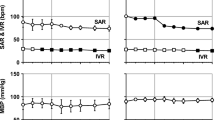Summary
Using two-stage coronary-ligation-, digitalis-and adrenaline-induced ventricular arrhythmias in beagles, antiarrhythmic effects of AN-132 were examined, and the minimum effective plasma concentration for each arrhythmia model was determined. AN-132 suppressed all the arrhythmias, and the minimum effective plasma concentrations for arrhythmias induced by 24-hour coronary ligation, 48-hour coronary ligation, digitalis, and adrenaline were 3.4–4.6, 1.5–2.3, 0.83, and 9.3 μg/ml, respectively. The concentration for adrenaline-induced arrhythmia was significantly higher than that of 24-hour coronary ligation arrhythmia, and it was also higher than that of digitalis arrhythmia. This pharmacologic profile is similar to those of pirmenol and mexiletine. Since AN-132 had no deleterious effects on the hemodynamics and the central nervous system, it may become a clinically useful antiarrhythmic drug.
Similar content being viewed by others
References
Sakai K, Yamazaki T, Takagi M. Antiarrhythmic effects of a novel diamine derivative, AN-132, on several animal models of cardiac arrhythmias.Tohoku J Exp Med 1987;151:443–451.
Ono K, Kiyosue T, Arita M. Multiple effects of AN-132, a novel antiarrhythmic drug, on action potentials and membrane currents of guinea-pig ventricular myocytes: A comparison with lidocaine (abstract). In:International Symposium on Basic Mechanisms of Arrhythmias. 1988:71.
Hashimoto K, Satoh H, Shibuya T, et al. Canine-effective plasma concentrations of antiarrhythmic drugs on the two-stage coronary ligation arrhythmia.J Pharmacol Exp Ther 1982;223:801–810.
Hashimoto K, Ishii M, Komori S, et al. Canine digitalis arrhythmia as a model for detecting Na-channel blocking antiarrhythmic drugs: A comparative study using other canine arrhythmia models and the new antiarrhythmic drugs, propafenone, tocainide, and SUN 1165.Heart Vessels 1985;1:29–35.
Shibuya T, Hashimoto K, Imai S. Effective plasma concentrations of antiarrhythmic drugs against sustained halothane-adrenaline arrhythmia in dogs.J Cardiovasc Pharmacol 1983;5:538–545.
Hashimoto K. Correlation between the antiarrhythmic effects of drugs on experimental ventricular arrhythmias and their cellular electrophysiological effects. In: Rand MJ, Raper C (eds).Pharmacology. Amsterdam: Elsevier Science, 1987:497–500.
Yamaoka K, Tanigawa Y, Nakagawa T, et al. A pharmacokinetic analysis program (MULTI) for microcomputer.J Pharmacobioyn 1981;4:879–885.
Hashimoto K, Watanabe K, Sugiyama A. Antiarrhythmic plasma concentrations of pirmenol on canine ventricular arrhythmias.Jpn J Pharmacol 1988;48:273–282.
Hashimoto K, Ishii M, Komori S. Antiarrhythmic plasma concentrations of mexiletine on canine ventricular arrhythmias.J Cardiovasc Pharmacol 1984;6:213–219.
Hashimoto K, Akiyama K, Mitsuhashi H. Antiarrhythmic plasma concentrations on cibenzoline on canine ventricular arrhythmias.J Cardiovasc Pharmacol 1987;9:148–153.
Hashimoto K. Electrophysiological correlates of antiarrhythmic effects of drugs and pharmacokinetic principles examined using canine ventricular arrhythmias. In: Papp JG (ed).Cardiovascular Pharmacology '87, Results, Concepts and Perspectives. Budapest: Academia Kiado, 1987:79–93.
Author information
Authors and Affiliations
Rights and permissions
About this article
Cite this article
Hashimoto, K., Watanabe, K. & Mitsuhashi, H. Antiarrhythmic effect of a new class 1 antiarrhythmic drug, AN-132, on ventricular arrhythmias in beagles. Cardiovasc Drug Ther 3, 683–689 (1989). https://doi.org/10.1007/BF01857620
Issue Date:
DOI: https://doi.org/10.1007/BF01857620




